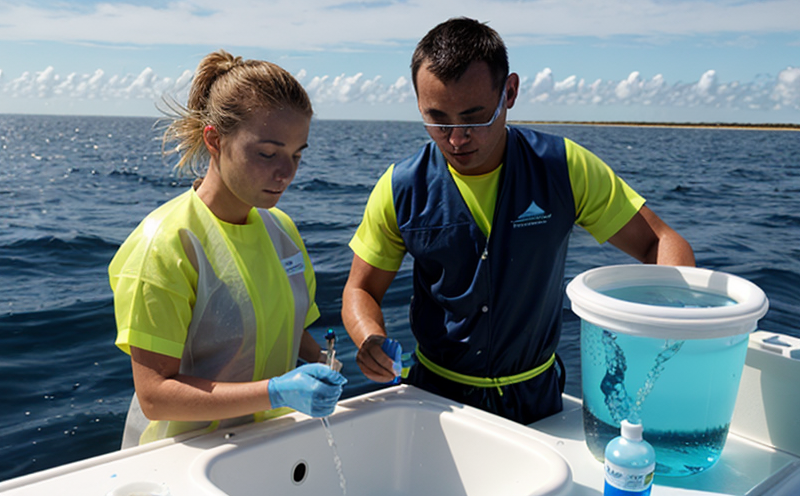ISO 7150 Ammonia Nitrogen Test in Seawater
The ISO 7150 standard provides a robust method for measuring ammonia nitrogen concentrations in seawater. This is particularly important as ammonia nitrogen can significantly affect marine ecosystems, contributing to water quality issues and potentially leading to ecological imbalances.
Seawater, unlike freshwater, presents unique challenges due to its salinity and varying temperature conditions. The presence of ammonia nitrogen can originate from a variety of sources including agricultural runoff, industrial discharges, or even natural processes like decomposition of organic matter. Accurate measurement is crucial for compliance with environmental regulations and for monitoring the health of marine environments.
The ISO 7150 test procedure involves several steps to ensure reliable results:
- Sample collection: Seawater samples are collected from representative locations using sterile containers to avoid contamination.
- Preparation: Samples are preserved by adding a fixative and stored at appropriate temperatures until analysis.
- Analysis: The test utilizes colorimetric methods or titration techniques, which are highly sensitive and precise for detecting ammonia nitrogen levels. The specific method chosen depends on the expected concentration range of ammonia in the sample.
- Data interpretation: Results are compared against established thresholds to determine compliance with environmental standards.
Understanding the role of ammonia nitrogen in seawater is critical for effective management strategies. By accurately measuring and monitoring these concentrations, stakeholders can take proactive measures to mitigate adverse effects on marine life and overall water quality.
The ISO 7150 method ensures consistency across different testing laboratories, making it a reliable benchmark for compliance and research purposes. This standardization helps in identifying trends over time and facilitates collaboration among international bodies involved in environmental protection.
Eurolab Advantages
At Eurolab, we pride ourselves on delivering exceptional service with a focus on precision, reliability, and customer satisfaction. Here are some of the key advantages our clients experience:
- Accurate and Reliable Results: Our laboratories adhere strictly to ISO 7150 standards for ammonia nitrogen testing in seawater, ensuring accurate and consistent results.
- Experienced Technicians: Our team consists of highly trained professionals with extensive experience in water quality analysis.
- Dedicated Client Support: We provide comprehensive support from sample collection to result interpretation, ensuring that our clients have all the information they need for informed decision-making.
- State-of-the-Art Equipment: Equipped with advanced instrumentation and technology, we offer the highest level of accuracy and efficiency in our testing processes.
- Prompt Turnaround Times: Clients can expect timely results without compromising on quality.
- Comprehensive Reporting: Our reports are detailed and include all relevant data to meet regulatory requirements.
We strive to provide services that exceed expectations, making us the premier choice for water quality testing needs.
Competitive Advantage and Market Impact
- Innovation Leadership: Eurolab leads the market in providing cutting-edge solutions for environmental testing. Our ISO 7150 compliance ensures that we are at the forefront of technological advancements.
- Regulatory Compliance: By adhering strictly to international standards, we ensure our clients meet all necessary regulatory requirements, enhancing their reputation and reducing risks associated with non-compliance.
- Global Reach: Our services are accessible worldwide, making us a go-to partner for multinational corporations and government agencies.
- Cost Efficiency: While maintaining the highest standards of quality, we offer competitive pricing that aligns with our clients' budgets.
- Client Satisfaction: Eurolab consistently delivers services that exceed client expectations, fostering long-term partnerships based on trust and reliability.
These advantages position Eurolab as a leader in the field of water quality testing, contributing to better environmental practices globally.
Use Cases and Application Examples
The ISO 7150 ammonia nitrogen test in seawater finds application across various sectors:
- Environmental Monitoring: Governments and environmental agencies use this method to monitor the health of marine ecosystems.
- Agricultural Impact Assessment: Farmers can assess the impact of agricultural practices on nearby coastal waters by measuring ammonia nitrogen levels.
- Industrial Compliance: Industries discharging into seawater must comply with stringent environmental regulations, and this test helps them ensure compliance.
- Research Institutions: Universities and research institutions use this method to study the effects of climate change on marine ecosystems.
In each case, accurate measurement is critical for effective management strategies. For instance, if a coastal community notices increased ammonia nitrogen levels, it can be indicative of pollution from agricultural runoff or industrial discharges. Timely detection allows for corrective actions to be taken before significant damage occurs.
Our services are designed to meet the specific needs of our clients across these diverse sectors, providing them with the tools necessary to make informed decisions about their environmental impact and compliance obligations.





